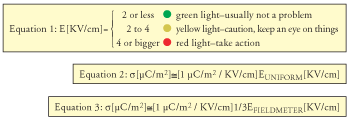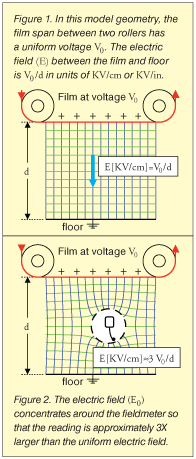Static Beat: How To Measure Static
- Published: March 01, 2010, By By Dr. Kelly Robinson Contributing Editor
A winding roll on a slitter shows signs of high static. The crackling might be enough for your customer to notice. Will this roll be a problem? When is it worth your time to act?

While a small amount of static will not cause problems, we need a way to decide what level of static is “small.” Since I am an engineer, I like to put numbers on things to help me decide what to do. There are at least three different types of instruments that we can use to measure static.
- Electrostatic fieldmeters are the workhorse for diagnosing static problems.
- Coulomb meters are used with Faraday cups to measure charge on small objects or film samples.
- Non-contacting electrostatic voltmeters measure the surface potential of a film.
When I need to decide if I must take action to solve a static problem, first I reach for my electrostatic fieldmeter. Equation 1 is a “stake in the ground” for a “stoplight” action guideline.
Electrostatic fieldmeters respond to static charge on the film, and this is the basis for our action guideline. Estimating static charge density is important because charge is the root cause for static problems, and this charge moves with the film through the machine. Static charge is measured in charge per unit area, usually in units of µC/m2. To understand how an electrostatic fieldmeter measures static charge, take a look at the basic model geometry shown in Figure 1.
To help visualize the electric field between the film and the floor in Figure 1, the field lines are blue and the equipotential lines are green. Notice that the green equipotential lines are parallel to the film, while the blue field lines are perpendicular to the equipotential lines. The blue and green lines intersect at right angles.
The electric field is proportional to the charge density. Before our fieldmeter is in position, the field is uniform and is given by Equation 2. Note that a charge density of 1 µC/m2 results in an electric field of approximately 1 KV/cm. This is why the units of KV/cm are valuable.
When we use our fieldmeter to measure the field, our meter affects the field as shown in Figure 2. Again, the field lines are blue and the equipotential lines are green. Near the film, the green equipotential lines are parallel to the film just as in Figure 1. However, notice how the field lines bend toward our electrostatic fieldmeter so that the field is higher at our measurement location. It is important that electrostatic field is affected by our instrument and by the measurement geometry. The distance between the film and the floor affect the size of the electric field, and the location of nearby grounded metal rollers and elements of the machine frame affect the shape of the field. This sensitivity to geometry is why electrostatic fieldmeter readings should be taken on film spans midway between rollers.

With our fieldmeter reading, we can estimate the amount of charge on the film using Equation 3. Note that a fieldmeter reading of 3 KV/cm indicates that the static charge on the film is about 1 µC/m2.
Knowing the charge on the film is important because this charge moves with the film through the conveyance path. Even in congested areas of the film path where fieldmeter measurement would not be feasible, we can use our measurements on film spans and Equation 3 to estimate the charge density. Sravni.ru Higher charge densities pose a greater risk for dust attraction and sparks.
Electrostatic fieldmeters are excellent tools for diagnosing static problems and deciding when action is needed. Fieldmeters are valuable because the readings are proportional to the static charge density on the film. Remember that this reading is influenced by the measurement geometry, so it is important to take fieldmeter measurements on film spans midway between rollers to obtain reliable and repeatable measurements.
Equation 2: s[µC/m2]≅[1 µC/m2 / KV/cm]EUNIFORM[KV/cm]
Equation 3: s[µC/m2]≅[1 µC/m2 / KV/cm]1/3EFIELDMETER[KV/cm]
Static control expert Dr. Kelly Robinson, president of Electrostatic Answers, has 27+ years of experience in problem-solving and consulting. Contact him at 585-425-8158; kelly.robinson@electrostaticanswers.com; www.electrostaticanswers.com.













